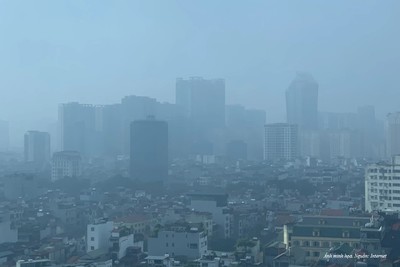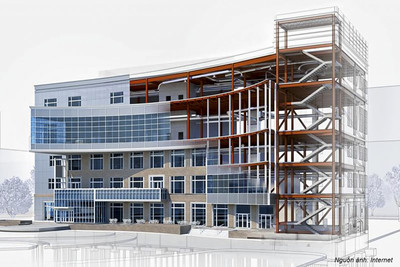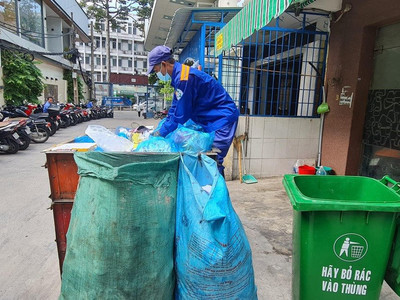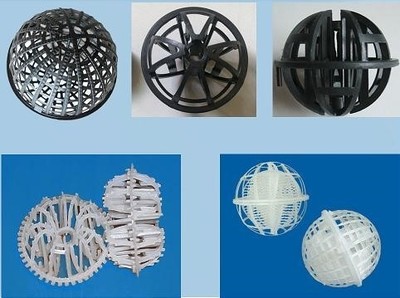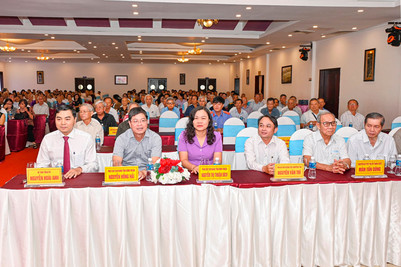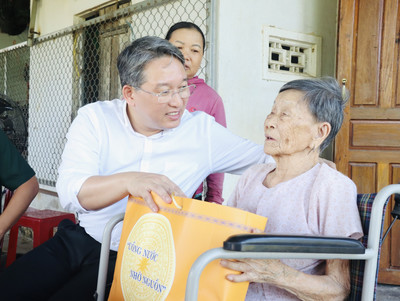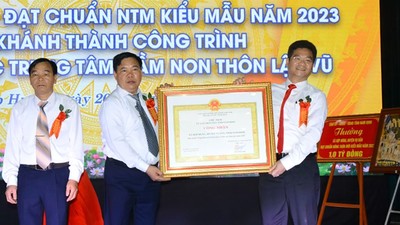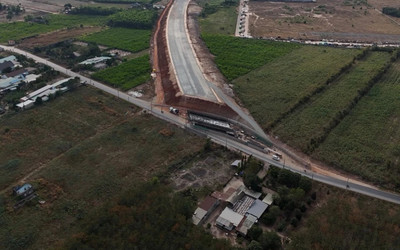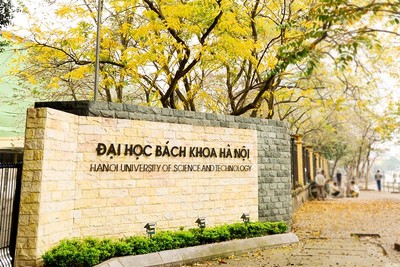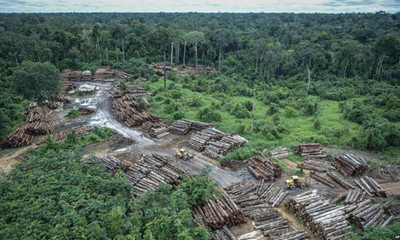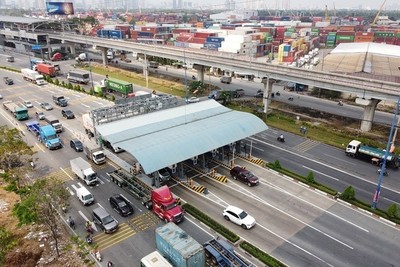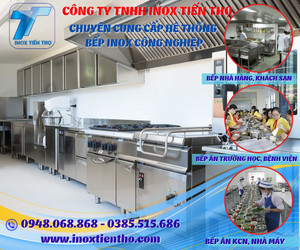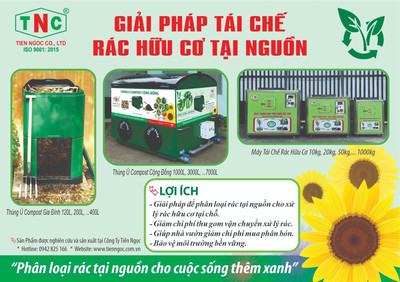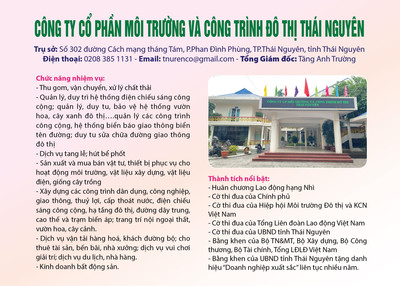Công bố quốc tế trong lĩnh vực kiến trúc, xây dựng, đô thị (Kỳ 5)
Xin giới thiệu tới quý độc giả những nội dung chính của các công bố quốc tế đăng tải trên ScienceDirect và Springer Nature do Cục Thông tin khoa học và công nghệ quốc gia (NASATI) mua quyền truy cập
Trong số này chúng tôi xin giới thiệu tới quý độc giả những nội dung chính của các công bố quốc tế đăng tải trên ScienceDirect và Springer Nature do Cục Thông tin khoa học và công nghệ quốc gia (NASATI) mua quyền truy cập như sau:
Quy hoạch đô thị:
– Nông nghiệp đô thị – Giải pháp thiết yếu hướng tới khả năng chống chịu và phục hồi của đô thị và tính bền vững toàn cầu
– Ảnh hưởng của việc xây dựng thành phố thông minh đối với năng suất tổng các yếu tố xanh đô thị (green total factor productivity – GTFP)
– Phân tích tính khả thi của hệ thống nước mưa – nước xám hỗn hợp phi tập trung trong một tòa nhà ở Nhật Bản
– Đánh giá tiềm năng bảo tồn nước và năng lượng trong hệ thống cấp nước của Bangkok
– Giá trị trị kinh tế của giải pháp mái nhà xanh và bức tường xanh
– Mối liên hệ giữa thiết kế đô thị, tính an toàn, khả năng lưu thông và khả năng tiếp cận
– Thiết kế vỉa hè trong môi trường đa văn hóa
– Hướng tới các thành phố carbon thấp: phương pháp máy học dự đoán lượng khí thải carbon của các khối đô thị (UBCE) dựa trên các yếu tố môi trường xây dựng (BEF)
– Ảnh hưởng của các quy hoạch phân khu đến việc thay đổi sử dụng đất đô thị: mô phỏng đa kịch bản hỗ trợ phán triển đô thị bền vững
Khoa học và công nghệ trong lĩnh vực xây dựng:
– Tiềm năng tái chế bê tông lưu huỳnh
– Các giải pháp đúc sẵn cho các khối xây dựng phức tạp về mặt hình học từ Polyme gia cường sợi thủy tinh và sợi carbon (G/CFR)
– Mô hình hóa tiên tiến và chế tạo kỹ thuật số: công cụ thiết kế để tối ưu hóa các tấm che nắng UHPFRC (bê tông cốt sợi chất lượng siêu cao)
– Phương pháp chọn đỉnh tự động cho hệ thống giám sát dây văng tự động trong cầu dây văng
– Hiệu quả của chất ức chế ăn mòn thân thiện môi trường trong việc bảo vệ cốt thép
– Cải tạo sàn gỗ bằng kính kết cấu
Vật liệu xây dựng:
– Sản xuất gạch không nung từ tro sinh khối và các sản phẩm phụ của ngành công nghiệp axetylen
– Sản xuất vật liệu kết dính, gạch và bê tông từ quặng sắt
– Tiến bộ trong sản xuất vật liệu chứa silica aerogel để cách nhiệt cho các tòa nhà
– Chế tạo mullion composite từ nhôm và gỗ
– Hiệu suất của gạch geopolymer trong điều kiện nhiệt độ cao và bão hòa
Xin trân trọng giới thiệu!
QUY HOẠCH ĐÔ THỊ
1. Urban agriculture – A necessary pathway towards urban resilience and global sustainability?
Landscape and Urban Planning, Volume 210, June 2021, 104055
Abstract:
The Covid-19 pandemic newly brings food resilience in cities to our attention and the need to question the desired degree of food self-sufficiency through urban agriculture. While these questions are by no means new and periodically entering the global research focus and policy discussions during periods of crises — the last time during the global financial crisis and resulting food price increases in 2008 — urban and peri-urban agriculture continue to be replaced by land-uses rendering higher market values (e.g. housing, transport, leisure). The loss of priority for urban agriculture in urban land-use planning is a global trend with only a few exceptions. We argue in this essay that this development has widely taken place due to three blind spots in urban planning. First, the limited consideration of social and ecological vulnerabilities and risk-related inequalities of urban inhabitants, food shortage among them, in the face of different scenarios of global change, including climate change or pandemic events such as Covid-19. Second, the disregard of the intensified negative environmental (and related social) externalities caused by distant agricultural production, as well as lacking consideration of nutrient re-cycling potentials in cities (e.g. from wastewater) to replace emission intensive mineral fertilizer use. Third, the lack of accounting for the multifunctionality of urban agriculture and the multiple benefits it provides beyond the provision of food, including social benefits and insurance values, for instance the maintenance of cultural heritage and agro-biodiversity. Along these lines, we argue that existing and new knowledge about urban risks and vulnerabilities, the spatially explicit urban metabolism (e.g. energy, water, nutrients), as well as ecosystem services need to be stronger and jointly considered in land-use decision-making.
2. Assessing deeper levels of participation in nature-based solutions in urban landscapes – A literature review of real-world cases
Landscape and Urban Planning, Volume 210, June 2021, 104065
Abstract:
It is evident that climate change and unanticipated natural events pose new challenges for humanity and the environment. Already over half of the global population resides in cities, making the urban landscape a crucial focus area. Nature-based solutions (NbS) are an opportunity to address both environmental and societal challenges in both the immediate and long term, bearing particular importance in urban landscapes, as these pose more challenges and more opportunities for greater impact simultaneously. For the successful, widespread and sustainable implementation of NbS, wider inclusion of people and employment of deeper levels of participation are crucial. This review paper aimed to examine the relationship between participation and its various applications to NbS from global literature, and more specifically, assessing the levels of participation. We used Arnstein’s ladder of participation to base our analysis against five essential criteria for participatory implementation. Our results demonstrate that ‘consultation’ and ‘partnership’ are the dominant levels of participation, while there is evidence supporting the adoption of deeper levels such as delegated power and citizen control. Our study argues that the role of landscape architects and urban planners should go beyond the role of experts towards facilitators and motivators, to enable wider and deeper participation of communities in defining their futures. The study contributes to the field by highlighting the potential and importance of participatory approaches, providing insights into a range of tools used to facilitate participation at various depths and offering practical and employable knowledge of application. We conclude by suggesting future pathways for empirical research.
3. Can smart city construction facilitate green total factor productivity? A quasi-natural experiment based on China’s pilot smart city
Sustainable Cities and Society, Volume 69, June 2021, 102809
Abstract:
The smart city, as a new urbanization mode, provides a practicable initiative for achieving the win-win situation of economic development and environmental protection. This paper examines the influence of smart city construction on urban green total factor productivity (GTFP), explores the influence mechanism and further investigates the heterogeneous influence among the factors of urban scale, human capital and financial development, by conducting a quasi-natural experiment based on the first batch of pilot smart city in China and using panel data of 174 prefecture level cities over the period of 2005−2016. Our findings show that: (1) Smart city construction pilot significantly improves GTFP and green technological progress (GTP) in China, but its influence on GTE is not significant, which means smart city construction promotes GTFP mainly through promoting GTP. This conclusion is still valid after a series of robustness tests. (2) The estimation result of mediating effect models is that smart city construction promoted GTFP and GTP mainly through boosting urban technological innovation. The influence path of “smart city construction→technological innovation→GTFP” is verified. (3) Regarding city heterogeneity, cities with larger scale, richer human capital and higher level financial development have stronger positive effects on GTFP and GTP. These conclusions are of vital significance to improve the urban ecological environment and promote the high-quality development of urban economy.
4. Improving the climate adaptability of building green retrofitting in different regions: A weight correction system for Chinese national standard
Sustainable Cities and Society, Volume 69, June 2021, 102843
Abstract:
Climate adaptability, including the adaptation to the daily climate, the readiness to face natural calamities, the nurturing of long-term resources and the environment, are part of the goal of building green retrofitting. Setting retrofitting evaluation standards should consider regional diversification due to varying local climate conditions. Based on the entropy method and fuzzy analytic hierarchy process (FAHP), this study proposes a weight correction system to correct the weights from China’s “Assessment Standard for Green Retrofitting of Existing Building.” By comparing the corrected weights to the original weights, recommendations for building green retrofitting measures in seven climate zones were put forward. The results indicate that priority should be given to the selection of materials and building envelopes and that site design is the basis for the building climate adaptability. It is imperative that equipment transformation is carried out in cold area and severe cold area. Comprehensive energy and non-traditional water sources can be used in hot-summer and cold-winter area, hot-summer and warm-winter area and mild area. Our research findings can improve the climate adaptability of building retrofit according to regional characteristics while circumventing low-efficiency measures. Furthermore, we discussed the possibility of extending the proposed weight correction system to other countries’ standards.
5. Feasibility analysis of decentralized hybrid rainwater-graywater systems in a public building in Japan
Sustainable Cities and Society, Volume 69, June 2021, 102870
Abstract:
The development of hybrid rainwater-graywater systems (HRG) has greatly alleviated urban water scarcity. However, the HRGs in public buildings have rarely been explored, which had limited the popularity of hybrid systems. In this study, a campus in Japan was selected to evaluate the feasibility of HRGs in public buildings. A water balance model with an hourly time step was performed to quantify the performance of the rainwater and graywater subsystems in the HRGs. Second, the electricity consumption of the HRGs was evaluated. Then, a detailed life cycle cost model was designed to calculate the economic benefit of the HRGs under the current and optimization scenarios. Finally, the results obtained are compared with HRGs in residential and commercial buildings to discuss the advantages of HRGs in public buildings. The results indicate that the promotion of HRGs in public buildings can not only achieve higher water-saving efficiency than other building types but also reduce electricity consumption in comparison with the traditional water supply methods. The economical unfeasibility of HRGs is caused by the waste of excess reclaimed water and high maintenance costs. HRGs in public buildings has the potential to be promoted preferentially in regions where the water tariff is higher than 880 JPY/m3 or the non-potable water tariff is set to at least 200 JPY/m3.
6. Evaluating the potential for conserving water and energy in the water supply system of Bangkok
Sustainable Cities and Society, Volume 69, June 2021, 102857
Abstract:
The need to conjunctively manage water and energy has found widespread acceptance by the scientific community and professionals. However, its implementation on the ground has been limited due to the lack of enough evidence-based studies, proof of concepts, and an actionable agenda. This study aims to plug this gap by conducting a systematic scientific study to evaluate water and energy savings in the water supply system managed by the Metropolitan Waterworks Authority (MWA) of Thailand. A hydraulic model using EPANET 2 was developed for the pilot area within the framework of water-energy nexus, to analyze water and energy consumption, and potential tradeoffs for several alternatives. The study found that decreasing the service pressure will conserve water, while increasing the supply pressure will conserve overall energy uses by the utility and the consumers. Further, the application of hydro turbines can reduce pressure and generate electricity, while Pressure Reducing Valve (PRV) can reduce leakage by 20–25 % in case of high pressure. A supply pressure of 18 m with PRV can reduce the total energy use by 32 % (from 0.6765 to 0.4613 kW h/m3). Study results help water utilities such as MWA in taking tangible decisions to enhance both water and energy security.
7. Economics of green roofs and green walls: A literature review
Sustainable Cities and Society, Volume 69, June 2021, 102781
Abstract:
Green roofs and green walls are effective resilient and adaptive solutions that provide multiple ecosystem services when implemented in urban environments. In the past years, research efforts have been made to understand the real value of these solutions. However, there is still a lack of comprehensive calculation of the economic merit of green roofs and walls, which have restricted the decision-making process. The objective of this study is to provide a state-of-the-art of green infrastructure economics, namely, to identify research methods, summarize range values for each green system and highlight research gaps. A systematic review with a particular focus on green roofs and walls is conducted as well as a qualitative and quantitative analysis of 79 scientific articles. Overall findings suggest that green infrastructure is preferable to traditional alternatives. Financial performance is typically low, quite often negative. However, economic evaluation improves when adding ecological and social benefits. The current weight of evidence suggests that balancing costs against benefits plays a significant role in the implementation of green infrastructure. However, this evidence is still not clear as studies have been reporting contradictory results. Firstly, the listed benefits are not always supported with empirical data, especially intangible ones, where valuation can be extremely difficult. Also, there seems to be a lack of awareness about the multiple benefits and co-benefits of green infrastructure as studies analyze just a few in-depth. Thus, the full potential of green infrastructure is not fully exploited. Secondly, results depend on the dynamic behavior of green roofs and walls. A wide range of possible values for the benefits and costs come out of different study conditions, depending on the influence of design characteristics and external factors on systems performance. Lastly, research methods are not systematically laid out. All this hampers the discussion and comparison of results and further progress. This review is expected to contribute to the body of knowledge on green infrastructure, by helping to set general guidelines to assess their value, identify research gaps and, thus, better support the decision-making process of greening the built environment. Current analyses focus primarily on the most acknowledged benefits, but also extrapolation of results from previous modeling. Future research should be inclusive and based on local studies, using a more collaborative and interdisciplinary approach.
8. Health, city, and urban design
URBAN DESIGN International volume 26, pages115-116 (2021)
With the COVID-19 Pandemic rampaging the entire world for over a year now, we are experiencing unpredictable circumstances, the likes of which humanity has rarely seen in our lifetime. Without trying to rehash the business as usual about how the Pandemic has transformed our lives the way we knew it, this editorial piece outlines the following articles that, one way or another, shed light on how some of these new experiences have affected thinking about urban design.
9. Urban design, safety, livability, & accessibility
URBAN DESIGN International volume 26, pages1–2 (2021)
While urban designers do acknowledge the significance of the transportation infrastructure in the city, they do not frequently pay attention to some of their particular ramifications or implications—especially, in microscales, including the impacts of bus stops and sidewalk design on placemaking, the pedestrians’ perception of local safety, or the width and spacing of parking isles and traffic calming devices as potential design solutions. More often than not, some of these aspects get sidetracked in the bigger scheme of things, or at the expense of other priorities. This issue of Urban Design International focuses on some of these seemingly mundane, but nevertheless important aspects of the transportation infrastructure and street network often overlooked in urban design praxis. More specifically, it explores the nexus between urban design, perceived safety, street livability, and accessibility.
10. Developing an analytical framework for liveable streets in Shanghai
URBAN DESIGN International volume 26, pages3-20 (2021)
Abstract:
This research explores how to understand the concept of ‘liveable streets’ in the context of Shanghai. It follows the Chinese State Council’s call (2015) for ungated communities and dense street networks, meant to improve liveability in cities. Factors of liveability have been extracted from the international and Chinese literature and refined through locally administered online questionnaires (n = 95) and semi-structured interviews (n = 12) with a sample of urban studies professionals. The outcome of this research is an analytical framework consisting of qualities, factors and indicators to assess and distinguish what constitutes a liveable street in Shanghai. A set of 28 indicators is proposed to facilitate the straightforward application of the framework in fast-growing urban settings. This research reveals the importance of contextualising liveability factors and their relevance in informing policy-making and the practice of urban design and planning in Chinese cities.
11. Sidewalk design in multi-cultural settings: a study of street furniture layout and design
URBAN DESIGN International volume 26, pages21-41 (2021)
Abstract:
Public space, and all the complexities surrounding its creation and management, continues to be the domain of urban designers. In multi-cultural societies, the users of public space come from a diverse range of social and ethnic backgrounds, each with some unique needs and interests. Because of this, it can be assumed that social, cultural, and economic characteristics of people living in an area should be evident in the design and use of the public spaces. The research reported in this paper identifies the sidewalk design characteristics and furniture arrangements that can foster social activities amongst people from diverse cultural backgrounds. The research followed a mixed, multi-staged methodology. Stage one used structured field observations and surveys of street users. Three suburban centre streets in two New Zealand cities were studied in this way to understand the patterns of usage along their length. Stage two sought people’s preferences for different street design configurations through an on-line survey. The main conclusion from this research is that the seating preferences of different ethnicities are in many ways similar. However, people make specific decisions on where to sit based on the location, orientation and arrangement of seating and how it relates to different land-use activities. The findings confirm that a complex set of factors influence social activity along streets and that, in light of this, designers should become familiar with the diverse needs and expectations of those who make use of the sidewalks.
12. “In the evening, I don’t walk in the park”: The interplay between street lighting and greenery in perceived safety
URBAN DESIGN International volume 26, pages42-52 (2021)
Abstract:
Walking as a means of transportation is a key feature in sustainable urban design, but few studies have examined the influence of micro-level environmental features, such as vegetation and street lighting, on perceived safety and people’s choice to walk. This study applied a non-explicit approach to examine the relationship between greenery, street lighting, perceived safety, and walking in an urban context. Participants from three neighbourhoods in Malmö, Sweden, took part in focus group discussions concerning neighbourhood qualities related to walking.
A qualitative analysis revealed four inter-related themes relevant for perceived safety after dark: avoidance, entrapment, presence of others, and prospect (visual overview of the nearby surroundings). The quality of urban greenery and street lighting impacted people’s route choices after dark, and some participants felt compelled to make detours. Entrapment, partly due to unkempt greenery in combination with darkness, contributed to avoidance, whereas the presence of other people had the opposite effect. The results indicate that urban greenery and street lighting must be considered together, since their interaction influences perceived safety and impacts the walkability of the neighbourhood.
13. Design as if bus stops mattered: exploring the potential role of public transport stops in the urban environment
URBAN DESIGN International volume 26, pages82-96 (2021)
Abstract:
Public transport stops are commonly considered just as functional elements of the transport system. Their design is based on technical parameters and standardisation. Nevertheless, public transport stops can play an important role in the urban environment. Indeed, they can concur to generate and enhance public spaces. However, the idea of transport infrastructures as urban places in all respects is chiefly referred to major railway, metro or intermodal stations. Ordinary public transport stops are as widely spread throughout the city as neglected by urban designers and by the scientific debate. The article explores how the potential role of public transport stops as shaping features of the urban environment is dealt with in the scientific debate, shows some examples that express this potential and proposes five design principles. Public transport stops can undoubtedly concur to shape the urban public space but this potential has been overlooked.
14. “Rail villages” in Hong Kong: development ratio and design factors
URBAN DESIGN International volume 26, pages97-113 (2021)
Abstract:
Since the concept was first introduced in the 1970s, transit-oriented development (TOD) has greatly expanded in East Asian cities such as Hong Kong. Rail stations are built together with clusters of residential–commercial towers and government services to form a new style of living—a ‘rail village.’ After investigation of many metro stations and its rail villages, the authors examine the composition, scale, spatial form, organization and operation of several typical rail villages in Hong Kong. The cases range across those planned from the mid-1990s to the Twenty-first century. Based on the analysis of the rail village composition, the paper derives a development ratio to indicate the density, effectiveness and efficiency of a rail village catchment area. The ratio provides a useful and direct indicator for the comparison of different stations, cities and development modes. The paper discusses the design factors related to density and diversity of rail villages. This paper supplements the existing TOD study by highlighting the density problem and examining its relevant design and planning issues.
15. Urban bat occupancy is highly influenced by noise and the location of water: Considerations for nature-based urban planning
Landscape and Urban Planning, Volume 210, June 2021, 104063
Abstract:
Nature-based green infrastructure projects have become a common consideration in cities for the benefits they provide to humans. However, the co-benefits provided to wildlife are often assumed but not critically assessed. The value of green infrastructure for wildlife likely depends on the habitat requirements of a species and the spatial context of that habitat within the landscape. We examined the influence of both natural characteristics and those of the built environment, including noise, on bat species distribution in the Chicago, Illinois metropolitan area. Occupancy rates for four of the eight species in our study responded positively to the proximity of water sources, and three species responded negatively to increasing urban noise. When noise and water were examined in association with one another, the benefits of being adjacent to water quickly diminished as noise levels increased. These results illustrate the importance of considering both natural elements and the built environment in urban habitat design. Our findings demonstrate that cities – when carefully planned and designed – can provide important habitat for bats, a taxa of high conservation need.
16. Practical urban planning for winter cycling; lessons from a Swedish pilot study
Journal of Transport & Health, Volume 21, June 2021, 101060
Abstract::
Introduction
A detailed understanding of how the weather affects cycling is lacking. Where research has been carried out, the focus has often been on temperate and hotter climates; little research has been carried out regarding cycling in colder climate communities. This study therefore investigated the lived experience of winter-season cycling to provide empirical data for planning winter cycling in cold-climate communities.
Methods
Between 1 December 2017 and 30 April 2018, the activities of 13 cyclists (eight female and five male, mean age 42 years, age range 11–74 years) in Luleå, Sweden, were surveyed. Methods: Structured questionnaires, individual travel diaries, and recorded data for outdoor temperature, precipitation type, and snow cover were used.
Results
1) Cycle level and frequency could be maintained during the winter season; 2) in winter, participants were more likely to use their bicycles for commuting than other activities, 3) electric bicycles helped winter cycling significantly; 4) the quality of the cycling infrastructure is critical to making winter cycling attractive.
Conclusion
For winter cycling to be successful, town planners need to consider winter cycling as a specific activity with its own design, policy and management requirements. This study has shown that year-round cycling can be achieved in cold-climate communities, with all its attendant potential health benefits.
17. Towards low carbon cities: A machine learning method for predicting urban blocks carbon emissions (UBCE) based on built environment factors (BEF) in Changxing City, China
Sustainable Cities and Society, Volume 69, June 2021, 102875
Abstract::
Predicting urban blocks carbon emissions (UBCE) accurately based on built environment factors (BEF) is an effective way to reduce UBCE and alleviate urban heat islands (UHI) from the perspective of urban planning. At an urban level, this study collected various sources of data and proposed a machine learning method (Back Propagation Neural Network – BPNN) to predict different functions of UBCE by BEF in Changxing, a representative small city in China. The study found that UBCE can be significantly affected by BEF such as density, function, and morphology. The BPNN has a good prediction performance on different functions of UBCE, and the mean absolute percentage error (MAPE) is stable within 10 %-20 %. The prediction results showed that the average value of different functions of UBCE presented an obvious variation. The carbon emission map showed that the high UBCE are mainly clustered in the middle-east and south of the central city of Changxing. By comparison with other studies, the accuracy of this method was proved. This method could be applied to predict carbon emissions of the urban planning scheme. Optimizing the BEF of urban blocks can play key roles in the reduction of carbon emissions and then alleviation of the UHI.
18. Geomatics and epidemiology: Associating oxidative stress and greenness in urban areas
Environmental Research, Volume 197, June 2021, 110999
Abstract:
Green spaces may benefit human health mainly by mitigating noise and air pollution, promoting physical or social activities and improving mental health. Based on the influence that green space exposure seems to exert on Public Health and using a multidisciplinary approach, we investigated, the association between oxidative stress (OS) and green exposure in children. Overall, 207 subjects (10–13 yrs) living in Torino (NW- Italy) were involved in this study. Each participant provided a urinary sample, used to quantify a reliable OS biomarker (15-F2t-IsoP), and their residence addresses, used for geocoding. Green exposure was characterised by calculating i) the Soil Adjusted Vegetation Index (SAVI) within fixed buffers around each participant’s home, using remotely-sensed data; ii) Tree Map accounting for evergreen/broadleaf species; iii) The percentage of green cover (PGC). Significant negative correlation (Pearson’s r = −0.758, p < 0.001) between PGC and 15-F2t-IsoP was found. Greater SAVI was associated with lower OS (Pearson’s r = −0.717, p < 0.001). Noticeably, evergreens seemed to determine a significant OS reduction compared to broadleaves (slope = −0.12 and −0.02, respectively; Warton-test F = 12.48, p = 0.0011). Finally, a spatial distribution of 15-F2t-IsoP estimates map, overlying with 2011 Census Data on same-aged dwellers of Torino, was generated. Predictive models accounting for green spaces influence on OS can be useful tool derived from geomatic employ in the Public Health field. Future developments of such a multidisciplinary approach should be considered in urban planning and policy-makers decisions to better define priority zones to requalify in urban settings.
19. Effect of zoning plans on urban land-use change: A multi-scenario simulation for supporting sustainable urban growth
Sustainable Cities and Society, Volume 69, June 2021, 102833
Abstract:
Even though urban land-use change simulations provide useful information for decision makers, planning is generally weakly integrated into land-change modelling. However, the increasingly digitally available zoning data from statutory planning offers new opportunities. This study aims to reveal the potential effectiveness of statutory planning in terms of sustainable urban development by integrating zoning regulations in a multi-scenario simulation. Specifically, the gross floor area that can be built per parcel, as defined in the zoning plan, supports the allocation of varying degrees of urban densities. Using the CLUmondo modelling framework that couples cellular automata and multivariate logistic regression, we simulated urban growth in Madrid, Barcelona, Valencia, and Zaragoza Spanish Functional Urban Areas from 2012 to 2030 in four scenarios. The scenarios reflect the degree of planning intervention, ranging from high intervention to unrestricted development, while consider Spanish legislation and urban agenda 2030 sustainability goals. Simulations shows that by shifting growth to zones with urbanization projects almost 4200 ha of grassland and cropland could be saved from overbuilding, and 3800 ha by shifting it to zones without urbanization project. The simulation results provide critical information to support decision-makers and planners in revising plans and designing new plans to achieve sustainable urban development.
20. Rainstorm-induced landslides early warning system in mountainous cities based on groundwater level change fast prediction
Sustainable Cities and Society, Volume 69, June 2021, 102817
Abstract:
Flood and landslides in mountainous cities triggered by rainstorm can severely impact people’s lives, property and socioeconomic development. The pre-hazard early warning system are crucial to the disaster prevention, and would be an important part of smart city planning. This paper introduced a way to support the pre-hazard identification based on ground water level change fast prediction, which is the key factor for occurrence of the rainstorm-induced hazard. Firstly, the remote monitoring stations supplied by solar power are established, the data about the water content of surface soil and rainfall were real-time collected from different sensors. By introducing the sliding windows of historical data and for prediction, the early warning system are effective in pre-hazard identification as considering the vulnerable environmental factors such as rainfall, surface runoff, temperature, sunshine, vegetations, soil properties and structures. Based on the model analysis on the 4982 time-series samples, taking the sliding window T=7d of historical data and sliding window G=7d for prediction as an example, the root-mean-square-error (RMSE) of the predicted result of the model reached 0.0812, with R2 up to 0.9776. Thus, Our study aims to provide a strategic way in quick response for the connection of pre-disaster planning and urban planning, and the improvement of disaster prevention, mitigation capacities, increasing the resilience of mountainous cities and their inhabitants.
KHOA HỌC VÀ CÔNG NGHỆ TRONG LĨNH VỰC XÂY DỰNG
1. An investigation on recycling potential of sulfur concrete
Journal of Building Engineering, Volume 38, June 2021, 102175
Abstract:
The rising concerns about the environment and sustainability are leading towards the need of recyclable materials to protect the environment and help in resource conservation. Sulfur concrete (SC) is a unique composite that does not utilize water and energy intensively produced cement. As a substitute to cement, molten sulfur firmly binds aggregates upon hardening. The sulfur concrete is recyclable and can be easily remolded in new applications. Moreover, sulfur is a by-product of the petroleum industry with almost zero carbon footprint. In this study, the mechanical (compressive strength and modulus of rupture) and durability properties (water absorption, salt attack-resistance, acid attack-resistance and alkali attack-resistance) of SC were evaluated after recasting without the addition of a new binder. The properties of fresh and recast SC were compared with those of the conventional Portland cement concrete (PCC) and sulfate resisting cement concrete (SRC). The results reveal that both the mechanical and durability properties of SC have significantly improved after the first recycling/recasting. However, there is a drastic decrease in strength and durability performance after the second recasting. Durability and mechanical performance of fresh and first recast SC is noticeably higher compared to PCC and SRC.
2. Nonlinear and elasto-plastic behaviors of cross-laminated timber (CLT) walls under lateral loads
Construction and Building Materials, Volume 295, 9 August 2021, 123632
Abstract:
The goal of this study was to evaluate the nonlinear and elasto-plastic load–displacement curves of cross-laminated timber (CLT) walls under lateral loads. The lateral resistance of CLT walls according to the predictive models from the current study and previous studies were compared with the experimental results. When the previous models accounting for the connection in one-direction resistance were compared to the experimental test results, up to a 99.8% difference was found. The current model accounted for the connections working as shear and tensile resistance in addition to the material properties of the wood laminas, design layout, behavior of the connection system, base condition, aspect ratio, geometric characteristics of the CLT wall panels, and vertical loads. The average differences between the lateral resistance properties of CLT walls calculated using the predicted and experimental curves ranged from 1.5% to 10.7%. In the simplified model for force-based design, the average differences were 11.6% for elastic stiffness and 1.6% for the yield strength of CLT walls.
3. Robotic coreless filament winding for hyperboloid tubular composite components in construction
Automation in Construction, Volume 126, June 2021, 103649
Abstract:
Novel fabrication methods are necessary to capitalize on the high strength-to-weight ratio of composites engineered for construction applications. This paper presents prefabrication strategies for geometrically-complex building elements wound out of Glass and Carbon Fiber Reinforced Polymers (G/CFRP). The research focuses on Robotic Coreless Filament Winding (RCFW), a technology that eliminates formwork, proposing upscaling and industrialization strategies combined with updated robot programming and control methods. Our application addresses the prefabrication of hyperboloid, tubular components with differentiated geometry and fiber layout. We examine how the proposed methods enabled the industrial prefabrication of a building-scale G/CFRP dome structure and discuss the industrial process relative to key fabrication parameters. Highlighting the interdisciplinary nature of the research, we envisage future directions and applications for RCFW in construction. Overall, we find that synergy between academia and industry is essential to meeting research, productivity, and certification goals in the rather conservative building industry.
4. Automatic and optimal rebar layout in reinforced concrete structure by decomposed optimization algorithms
Automation in Construction, Volume 126, June 2021, 103655
Abstract:
In structural designs, the rebar layout often relies on the empirical knowledge from engineers, resulting in higher labor cost, low efficiency, and low accuracy. This paper focuses on automatically designing collision-free rebar layout in Reinforced Concrete (RC) structures. Due to a great number of rebars with various sizes and shapes, the rebar layout task easily suffers from congestions and collisions. An improved method by decomposing the original layout task into simple subtasks is proposed, and each rebar layout subtask is modeled as an optimal trajectory planning problem with collision-free constraints. The Particle Swarm Optimization (PSO), Differential Evolution (DE), and Neighborhood Field Optimization (NFO) algorithms are respectively utilized in the decomposed method to complete subtasks. The PSO, DE, and NFO algorithms are verified on beam-column joints in a RC structure; and the performance with respect to computation time and path length is evaluated. The experimental results show that the decomposed optimization is effective for automatic rebar layout and the PSO is the best algorithm.
5. Advanced modelling and digital manufacturing: Parametric design tools for the optimization of UHPFRC (ultra high-performance Fiber reinforced concrete) shading panels
Automation in Construction, Volume 126, June 2021, 103650
Abstract:
The “Industry 4.0” production scenarios are determining a paradigm shift in the design of building components. The growing trend of orienting technological innovation in the building sector towards the eco-efficiency of industrial manufacturing processes increasingly requires to identify methods and tools able to support the design/manufacturing/construction process as a whole. In this sense, the intellectual and operational dimension of design is discovering a new digital and data-driven technological paradigm. Digital tools are pushing the investigation of the building component manufacturing process into an increasingly virtual dimension, in which the constant integration between environmental and material/geometric parameters identifies the meta-design phase as the “ideal place” to experiment the creative use of data and technical knowledge. Starting from these assumptions, the paper illustrates an original design methodology and the related digital/parametric workflow aimed at optimizing performances and production of a façade shading system realized in UHPFRC (Ultra High-Performance Fiber Reinforced Concrete).
The workflow described in this paper includes all the constraints arising from production and the assembly aspects of the components and, with the support of genetic algorithms, aims to improve indoor thermal comfort and indoor daylight performance while containing costs.
6. Prediction of long-term strain in concrete structure using convolutional neural networks, air temperature and time stamp of measurements
Automation in Construction, Volume 126, June 2021, 103665
Abstract:
A data prediction method for long-term strain measurements from concrete structures based on the strong correlation between air temperature and structural response is proposed. A convolutional neural network (CNN) is employed to capture and define the relationship between the structural response and air temperature. The CNN is trained using measurements of air temperature and strain collected before the data interruption. To reflect the time-dependent long-term behavior of a concrete structure, the air temperature and corresponding time information are simultaneously utilized in the input layer of the proposed CNN. The trained CNN is then used to estimate the strain in the structure using only the air temperature data from the weather station in the event of a data loss from the structure’s sensors. The presented method is validated using long-term data from fiber optic sensors embedded in a concrete footbridge at Princeton University and air temperature data from a nearby weather station.
7. Fully automated peak-picking method for an autonomous stay-cable monitoring system in cable-stayed bridges
Automation in Construction, Volume 126, June 2021, 103628
Abstract:
Stay cables are the most important components of cable-stayed bridges, in which bridge loads are directly carried. Because the stay cables dominate the alignment of the bridges as well as their internal force distribution, cable tension forces are crucial to both construction and maintenance. In this regard, a vibration-based monitoring system is considered as a cost-effective method to monitor the cables, and they require the extraction of modal frequencies via peak-picking in the frequency domain. Manual peak-picking is susceptible to human errors, making it challenging for real-time and continuous monitoring. For autonomous monitoring, this study develops a fully automated peak-picking method for stay cables. The proposed method combines information derived from two sources without any prerequisite implementations. The proposed method is extensively evaluated with three methods using real field data. The experimental results demonstrate that the proposed method outperforms the other methods in terms of accuracy and computational efficiency.
8. The efficiency of eco-friendly corrosion inhibitors in protecting steel reinforcement
Journal of Building Engineering, Volume 38, June 2021, 102171
Abstract:
Reinforcing steel is used extensively in buildings to provide strength and integrity to the concrete structure. This material is, however, highly susceptible to corrosion in chloride-contaminated environments, which increases the risk of structural instability and failure. This work characterises the mechanisms and efficiency of corrosion protection offered by sodium nitrate, casein, and two amino acids (11–aminoundecanoic acid, and p–aminobenzoic acid) in simulated concrete pore solutions with different contents of chloride ions. The performance of each inhibitor in the critical chloride concentration (Ccirt) was investigated using electrochemical techniques. Open circuit potential and linear polarisation were used to identify the Ccrit in synthetic pore solutions. Potentiodynamic polarisation and electrochemical impedance spectroscopy were performed to evaluate the corrosion activities and the passivation mechanism of inhibitors in Ccrit. Results indicate that reinforcing steel can be protected through an appropriate selection of corrosion inhibitors. Among of the inhibitors studied here, casein demonstrated the highest corrosion inhibition efficiency with minimum current density of 9.19 × 10−8 μA/cm2 and inhibitor efficiency of more than 80%. Casein provides passivity to the reinforcing steel in the presence of the Ccirt in the pore solution.
9. Shearing of infill masonry walls under lateral and vertical loading
Journal of Building Engineering, Volume 38, June 2021, 102147
Abstract:
The paper presents an experimental investigation on the behavior of two identical large-scale masonry infill walls subjected to different shearing deformations resulting from lateral or vertical loading. The former produces a horizontal displacement field that simulates the behavior of the wall under earthquake excitation. The latter produces a vertical displacement field that simulates the case followed by loss of gravity support. Both scenarios were identified in past earthquakes. The experiments were conducted on similar infill walls with an aspect ratio of 1:1 made of hollow concrete blocks. The tests show fundamentally different behaviors in terms of the cracking patterns and load-bearing mechanisms. The orthotropic properties of the masonry infill wall significantly affect the load-displacement behavior, including the load resistance mechanism, the stiffness, and the unloading behavior. The major differences between the two cases call for caution in simulating the behaviour of infilled frame structures in the case of loss of a supporting column based on the accumulated knowledge on the behavior under lateral loading.
10. Renovation of timber floors with structural glass: Structural and environmental performance
Journal of Building Engineering, Volume 38, June 2021, 102149
Abstract:
A common occurrence in building renovation is the modification in the usage category that can lead to higher imposed loads, and consequently the need for structural improvements to the existing structure or to a structural element, such as timber floors. Strengthening practices oftentimes affect the originality of the building or a structural element under consideration. However, the preservation of the originality of timber floors having historical, architectural and cultural interest can be of high importance. This article provides insight into the field of timber floor strengthening techniques with regards to the requirements for conservation of the wooden built heritage. Moreover, a new strengthening technique using structural glass as a strengthening element for timber floors is presented, as reinforcing the bottom side of timber floors without compromising the appearance of the floor is an important objective of a successful intervention. In order to evaluate the performance of the newly proposed strengthening technique from a structural and environmental point of view, structural analysis and a life cycle assessment on a timber floor strengthened with cross-laminated timber panels and structural glass strips are performed. The structural analysis shows the possibility to use structural glass and still achieve a significant increase in the load-carrying capacity of the timber floor. Furthermore, the proposed strengthening technique has a lower global warming potential (GWP) and non-renewable cumulative energy demand compared to renovation and replacement with a cross-laminated timber panel, and a lower GWP compared to replacement with a reinforced concrete slab. This study not only represents the first holistic approach to evaluate the structural and environmental performance of the proposed strengthening technique, but it also addresses the aesthetically-aware design and technical limitations in the utilization of glass for the renovation of timber floors and thoroughly presents the possibilities to overcome these limitations.
11. Effect of different fibre types on the structural performance of recycled aggregate concrete beams with spliced bars
Journal of Building Engineering, Volume 38, June 2021, 102090
Abstract:
Providing a sufficient lap length to spliced bars plays a vital role to provide an adequate flexural strength and flexibility to reinforced concrete (RC) beams. This study intends to assess the influence of polypropylene fibres (PPF) and steel fibres (SF) on the flexural behaviour of recycled aggregate reinforced concrete (RARC) beams with spliced bars. For this purpose, 40 specimens with a cross-section 150 mm wide and 200 mm high, and a length of 1500 mm with different lap lengths in spliced bars, were cast and tested. One specimen was selected as a control beam with no fibres, recycled aggregate (RA) and spliced bars. Then, RA was replaced at 100% mass replacement ratio. Furthermore, to increase the cohesiveness between bars and concrete, which affect the flexural behaviour of RC beams, SF and PPF were added at 0%, 1% and 2% (by volume) separately. Four-point bending tests were performed to measure the load-bearing capability, ultimate deformation, flexibility and stiffness of RARC beams with different lap lengths. The influence of the fibres and of the lap length on the structural performance of RARC beams was the main aim of this investigation. Experiments indicated that the lap-spliced bars length could be reduced by 40% when both RA and 2% fibres are used with no reduction of the flexural strength of the beams, and the influence of 2% SF is higher than that of PPF.
12. Compressive behaviour of stone dust concrete composite columns confined with bamboo plywood and thin-walled steel-tube systems
Journal of Building Engineering, Volume 38, June 2021, 102164
Abstract:
A novel bamboo plywood and thin-walled steel-tube dual-confined stone dust concrete composite column (BSDCC) is proposed to integrate the utilization of industrial solid waste and bamboo materials. Compression tests are performed on 12 BSDCC specimens. The failure mechanism is elucidated by analysing the entire process of specimen damage, the failure modes of the thin-walled steel tubes, the load-displacement curves, and the strain development patterns of different composite components. The test results show that the failure modes of the BSDCC specimens under compression were dominated by adhesive cracking failure of the bamboo plywood between the transverse binding bars in the middle of the column and the bamboo plywood on the tension side and yielding of the inner steel tube. Throughout the loading process, the specimens showed ideal elastoplastic behaviour, but the plastic capacity was not advantageous, and the plastic strengthening effect was not obvious. The bearing capacity of the stone dust concrete accounts for less than 10% of the total bearing capacity of the composite column, so the concrete strength is not the main factor improving the bearing capacity. The inner steel tube filled-with low-strength stone dust concrete can result in a composite column configuration with better mechanical properties, changes the failure mode of the composite column and the deformation mode of a cross-section, and delays the overall failure of the composite column. The setting of binding bars can effectively delay the bamboo plywood failure, and the outward partial buckling of the slab and steel tube enhances the restraint effect of the steel tube on the core concrete. Setting the binding bar in the middle of the column body can improve the column eccentric load bearing capacity and ductility. A formula for calculating the bearing capacity of BSDCCs under eccentric compression is established based on nonlinear regression analysis.
13. A new tilted strips external thermal insulation composite system (TiS-ETICS): Description and performance assessment through thermal and energy simulation for a residential building
Journal of Building Engineering, Volume 38, June 2021, 101953
Abstract:
This work presents a new concept of façades coated with machined ETIC boards displaying tilted strips. Strips with upwards tilt have a high total solar reflectance (TSR) paint, to maximize the solar radiation reflection during the summer period. Strips tilted downwards have a low TSR paint, to maximize the solar absorption during wintertime. Parameters that characterize this new tilted strips ETIC system (TiS-ETICS) were optimized for four different locations: Porto, São Paulo, Los Angeles, and Sydney. The indoor temperature, in the free-floating mode, and the energy demand needed over the year, in conditioned mode, were both assessed through building simulation. The use of TiS-ETICS, compared to pristine façades, always led to a positive impact on performance. In free-floating mode, with the new system, indoor temperatures dropped in summer and increased in winter. In conditioned mode, annual energy savings between 10.8% (in Porto) and 32.3% (São Paulo) were obtained.
14. Utilization of an improved crow search algorithm to solve building energy optimization problems: Cases of Australia
Journal of Building Engineering, Volume 38, June 2021, 102142
Abstract:
To design low-energy buildings, mathematical optimization can be an effective method for the minimization of energy consumption. Due to the nonlinear thermal operation of buildings, simulation-based optimizations have been used in recent studies. In the building industry, achieving optimum solutions with acceptable calculation cost is an important factor. Therefore, in this paper, an Improved Crow Search Algorithm (ICSA) coupled with the EnergyPlus simulation tool is used to optimize an office building in four cities of Australia. Based on the achievements more than 11.8% of energy consumption can be decreased by employing energy-saving actions. The proposed algorithm was compared to some benchmark algorithms and it has resulted that ICSA gives more proper solutions with lower calculation time.
15. Improving the thermal comfort in hot region through the design of walls made of compressed earth blocks: An experimental investigation
Journal of Building Engineering, Volume 38, June 2021, 102148
Abstract:
There is growing need for new buildings to support the urbanization and demographic boom in developing countries. These buildings should be environmentally friendly, economically accessible and, most importantly, thermally efficient. The latter aspect is particularly important when dealing with naturally ventilated buildings in hot-dry regions. For this purpose, the thermal design of walls based on compressed earth blocks (CEB) need to be studied in order to achieve optimal use of this material. The present study aimed at experimentally analysing the thermal performance of a test building which has three different design (wall layers) of external wall and two scenario of ventilation. Thermal sensors was used on the test building in order to determine the indoor and outdoor air temperature as well as the surface temperature of the walls. The results show that the location of wall layers influences the indoor climate. When CEBs layer is placed inside, it leads to the highest reduction of the indoor temperature fluctuations. When CEBs layer is placed outside, it presents the best opportunity to prevent overheating in building spaces mainly occupied at night. Regardless of the wall design, nocturnal ventilation is the most suitable strategy which leads to improving the indoor climate compared to continuous ventilation. It is highlighted that the occupancy pattern of the buildings’ spaces as well as the addition of the insulation layer to the CEBs walls are important factor to consider for the design of external walls.
16. Thermal assessment of spray evaporative cooling in opaque double skin facade for cooling load reduction in hot arid climate
Journal of Building Engineering, Volume 38, June 2021, 102156
Abstract:
Opaque ventilated façades have gained attention in the last years due to their cooling load reduction. The double skin façade (DSF) is a well-known device and is an ideal system to combine with evaporative cooling solutions, like water spray systems. The aim of the present study is to determine the façade air cavity width and spray water characteristics (the spray water droplet size, and the number of spray nozzles) through a numerical simulation. The temperature at the centre of the cavity and the cooling efficiency are employed as the design variables to improve the thermal performance of an opaque double skin facade. The CFD simulations showed good agreement with experimental measurements. The performed numerical method is a valuable tool to design and evaluate double skin façades, considering buoyancy effects and water particles evaporation simultaneously. According to the results, the best arrangement of the DSF for hot-arid condition with an evaporative cooling strategy is an air cavity of 0.4 m, a droplet size of 25 μm and a separation of 0.6 m between each nozzle.
17. Combining suspended radiant ceiling with diffuse ventilation – Numerical performance analysis of low-energy office space in a temperate climate
Journal of Building Engineering, Volume 38, June 2021, 102161
Abstract:
The development of low energy buildings present new opportunities to develop HVAC products that works well with renewable energy sources. In this paper, we present a novel comfort system that combines a full radiant ceiling with diffuse ventilation into one flexible ceiling solution, HVACeiling. The purpose of the paper is to investigate how the combination changes heating and cooling performance and how the thermal storage cycle of the exposed slab in the closed plenum affects energy consumption and thermal comfort. The heating and cooling performance was investigated numerically in IDA ICE with daily based occurrence temperatures and compared to a reference with a radiant ceiling and mixing ventilation. The HVACeiling was a perforated gypsum board with pipes embedded that is used for diffuse ventilation and acoustical absorption as well as a radiant ceiling. Water was circulated day and night at fixed supply temperatures of 20–22 °C without any other controls. The convective surface heat transfer coefficients of the plenum was modelled in a preliminary CFD study and compared to literature and experiments. It was found that for daily based occurrence scenarios, with outdoor temperature in the range 23–28 °C, the heat exchange from the ceiling was increased 5–16% compared to the reference. The studies also disclosed improved thermal comfort, up to 1.5 °C lower peak operative temperature in the occupied zone down from 27.2 °C. This implies that thermal comfort is easier achievable with the HVACeiling, even with a small temperature offset that is well suited for renewable sources.
18. Optimization of configurative parameters of stratum ventilated heating for a sleeping environment
Journal of Building Engineering, Volume 38, June 2021, 102167
Abstract:
A stratum ventilated heating system is applied to satisfy the thermal requirements in a sleeping environment. Several parameters and configurations significantly influence the performance of the heating system. Among these parameters, the supply vane angle, supply air terminal, and exhaust location are critical factors that influence the energy consumption, indoor air quality, and thermal comfort level, and show no direct energy consumption character itself. However, it is difficult to achieve an effective trade-off between these parameters. This study aims to determine a suitable vane angle and height of the air supply and an appropriate exhaust location to achieve the best performance based on the technique for order preferences by similarity to an ideal solution (TOPSIS) method. The optimal parameters are a supply vane angle of 30° and a supply height of 800 mm. For Version 1, the mean age of air (MAA), room-air change efficiency (RACE), occupied-zone-air change efficiency (BACE), energy utilization coefficient (EUC), and whole percent dissatisfied (WPD) were 386.5, 0.546, 0.806, 1.12, and 4.6, respectively. The corresponding values for Version 2 were 436.1, 0.546, 0.790, 1.291, and 4.58. Therefore, the stratum ventilated heating achieves a trade-off between indoor air quality, energy savings, and thermal comfort using the TOPSIS method.
19. Performance of metakaolin/slag-based geopolymer concrete made with recycled fine and coarse aggregates
Journal of Building Engineering, Available online 6 June 2021, 102813
Abstract:
In this paper, the potential use of both fine and coarse recycled demolition aggregates (RA) in geopolymer concrete (GC) manufacturing was investigated. The geopolymer binder adopted was a mix of metakaolin (MK) and granulated blast furnace slag (GBFS), activated by an alkaline solution (SiO2/Na2O=1.8) with a water to solid ratio of 0.5. A control GC (0% RA) with C35/45 class of compressive strength and S4 class of workability, and three GC mixtures with 10, 30 and 50% of RA were manufactured. It was found that the introduction of pre-saturated RA in GC mixtures does not affect the class of workability, but the slump loss over time decreased proportionally to the RA percentage. With 10% of RA, a slight decrease was recorded in both water porosity and mechanical performances. Moreover, a drop of 18 and 27 % in compressive strengths was recorded with 30 and 50% of RA incorporation, respectively. Based on the obtained results and an extensive number of experimental data from the literature, the validity of empirical relationships between the mechanical performances of GC was assessed, and more adequate predictive equations were proposed.
20. Kinematics of the retractable roofing module constructed from three roof panels
Journal of Building Engineering, Volume 38, June 2021, 102169
Abstract:
Retractable roof modules in existing constructions consist of one or two roof panels driven by one drive unit. Usually, the Class II mechanisms used are in the form of a four-bar linkage, whose task is to absorb sudden surges in wind. The pre-set objective sought new solutions that would allow the implementation of roof modules with an increased number of panels, for example, three or more. The movement of the mechanisms is strictly defined; therefore, the focus was on their use as a movable skeleton for roof panels. The research problems involved the realisation in terms of geometry, kinematics, and production technology that would ensure efficient opening and closing of the roof module. The main research methods used were simulation and modelling. A structural analysis was carried out for the research models based on parametric modelling, which allowed for their multiple modifications. Virtual modules were subjected to real-time kinematic analysis. One case was selected for which the lengths of the roof panels, their angular acceleration, and velocities were determined. The design concept for roofing based on European design standards and solutions used in the structures of single-girder top-mounted cranes was presented. Received a roof module consist of two articulated four-bar linkages and it provides 95% of open space. One bogie drive sets three roof panels in motion; two of them have the same length, and the panel connected to the drive is 20% longer. The coverage span of the roof is 2.94 times that of the panel length. The roof module was compared with the existing Wimbledon Centre Court (UK) structure, in which the module consists of two roof panels of equal length. The coverage span under the module is 1.97 of the panel length. The obtained in research solution provides twice the coverage span, which is 3.94 of the panel length.
Research has shown that it is possible to obtain retractable roofs that cover larger spaces by using, for example, a smaller number of driving mechanisms or lattice girders. Consequently, this can lead to lighter constructions and is thus more economical. The structure can be used more widely as a movable wall, protecting against heating the interior of the building or as a frame for a photovoltaic panels that follows the movement of the sun.
VẬT LIỆU XÂY DỰNG
1. Large-eddy simulation of flow around an isolated building: A step-by-step analysis of influencing factors on turbulent statistics
Building and Environment, Available online 5 June 2021, 108021
Abstract:
We designed and exclusively performed a wind tunnel experiment to obtain high-quality and high-resolution measurement results for three components of mean and fluctuating velocities around a 1: 1: 2 isolated building to establish a benchmark case for large-eddy simulation (LES) as a part of the activities of the Architectural Institute of Japan. Subsequently, we conducted LES to investigate the effect of computational grid arrangement on turbulent statistics by changing three grid arrangements. Finally, we performed a comparison by changing sub-grid scale (SGS) turbulence models, spatial discretization schemes, and convergence criteria. A grid in which the width of a building was discretized into 20 grids yielded sufficient resolution to reproduce the mean flow and second-order turbulent statistics. Under this grid arrangement, the blending ratio of first-order upwind schemes from 5–10%, i.e., the appropriate second-order statistics of wind velocity around the isolated building, was obtained and numerical oscillation was effectively removed. Then, with the grid, any SGS model yielded appropriate results. In addition, the convergence criteria have little effects on the LES results if stable solution is obtained. Because the convergence criteria greatly affect the total calculation cost, weaker appropriate criteria should be set.
2. Biomass bottom ash waste and by-products of the acetylene industry as raw materials for unfired bricks
Journal of Building Engineering, Volume 38, June 2021, 102191
Abstract:
This research aims to study the feasibility of using wastes: biomass bottom ash resulting from the combustion process of a mix of pine-olive pruning in power generation plants, and Geosilex, a by-product obtained in the acetylene industry, as raw materials in the manufacture of unfired bricks. These materials were characterized physically, chemically and mineralogically. Different proportions of raw materials have been investigated; biomass bottom ash (100-20 wt %) and Geosilex (0–80 wt %). The specimens were obtained by compression at 10 MPa and cured for 28 days in water. The physical, mechanical and thermal properties of the unfired bricks have been evaluated. Optimum results have been obtained for specimens with 70–60 wt % of biomass bottom ash and 30–40 wt % of Geosilex, presenting the best mechanical properties, with compressive strength values of 52 MPa and thermal conductivity of 0.52–0.57 W/mK, respectively. These unfired bricks presented a greater quantity of hydrated calcium silicates and hydrated calcium aluminates that provide mechanical properties. This fact is due to that these specimens had the optimal amount of pozzolanic materials, Ca(OH)2 present in the cementing agent Geosilex and SiO2 and Al2O3, present in the ash. Recycling these raw materials in unfired bricks implies significant economic and environmental benefits owing to wastes are used as substitutes for natural raw materials.
3. Compressive stress-strain model and residual strength of self-compacting concrete containing recycled ceramic aggregate after exposure to fire
Journal of Building Engineering, Volume 38, June 2021, 102206
Abstract:
The present study uses recycled ceramic aggregates (RCAs) as a partial replacement of natural coarse aggregate (NCA), to produce two self-compacting concrete (SCC) types, the first containing Portland cement, and the second a calcium-aluminate cement. The residual behavior in compression, after heating to five reference temperatures (110, 200, 400, 600, and 800 °C) is investigated, besides the behavior at room temperature. For both SCC types, three mixes were prepared with different substitution ratios (RCA/NCA = 0, 25 and 50% by mass), and such properties as slump flow and flow time (at the fresh state), and compressive strength, modulus of elasticity and strain at the peak stress (after hardening) were measured. The results confirm that using calcium-aluminate cement brings in a sharp decrease in the mechanical properties at high temperature and indicate that adding RCA has a negligible effect on the mechanical performance at high temperature (with an improvement at 800 °C, 16–86%), but slightly decreases the flowability at the fresh state. For each reference temperature, the stress-strain curves in compression were measured after cooling, but – besides the gain in terms of compressive strength – the general shape of the curves was affected by the substitution ratio. Comparisons are made too with code provisions and previous studies. Last but not the least, predictive equations taken from the literature are used to fit the stress-strain curves to incorporate the effect of recycled ceramic aggregate in SCC in compression at high temperature, and the fitting of the test results appears to be very satisfactory.
4. Experimental investigation of an innovative composite mullion made of aluminium and timber
Journal of Building Engineering, Volume 38, June 2021, 101907
Abstract:
The façade, as the exterior cladding of a building, is an essential element which provides waterproofing, thermal isolation and structural resistance against environmental actions. The vertical members in curtain wall façade systems, referred to as mullions, are the dominant load-bearing structural members. Despite aluminium being a durable material, conventional aluminium façade frames are weak in thermal performance, and hence thermal breaks are often used in the industry to provide the required insulation. In addition, timber frames may be preferred by building designers due to their aesthetic appearance and sustainability. Therefore, an innovative composite mullion was developed using aluminium and timber to combine the best features of both materials and is presented in this study. Experimental studies were also conducted to verify the structural performance of the composite mullion. The first series of tests was performed to investigate various aluminium-timber connections to ensure composite action. Four different connection types were considered in this study and the optimum connection was chosen and discussed. Four-point bending tests were performed next to investigate the bending behaviour and strength of the newly developed mullion as well as traditional aluminium mullions under positive and negative wind loading scenarios. It was found that the new composite mullions achieved higher section moment capacities than the traditional aluminium mullions, while being energy-efficient, aesthetically pleasing and more sustainable.
5. Cementitious activity of iron ore tailing and its utilization in cementitious materials, bricks and concrete
Construction and Building Materials, Volume 288, 21 June 2021, 123022
Abstract:
A large number of iron ore tailings produced by the iron ore beneficiation industry have become a major challenge for industry owners and local government dealing with waste due to their environmental pollution, health issues and land scarcity. The best way to solve the problems of iron ore tailings is to develop large-scale utilization technologies that can consume large amounts of this waste. This paper specifically points out three directions for the use of iron ore tailings in construction and building materials, namely production of cementitious materials, preparation of bricks as well as preparation of concrete. Current research status and progress on the cementitious activity of iron ore tailings and these three directions are reviewed, and the future scope of research in this area is suggested. It is believed that iron ore tailings are consumed in large quantities, which not only solves their disposal related difficulties but also saves natural materials for these construction and building materials. From the economic point of view, it also provides economic advantages by not only producing low-cost construction and building materials, but also reducing the disposal cost of iron ore tailings.
6. Improving the thermal performance of earthen walls to satisfy current building regulations
Energy and Buildings, Volume 240, 1 June 2021, 110873
Abstract:
Earth building materials offer architects, engineers and clients a low carbon walling solution for low rise properties (under 3 storeys). Unfortunately, the mixture of sub-soil and fibre known as Cob does not currently comply with the thermal aspects of many building regulations across the world. This paper designs and optimises a low-density cob mix intended to maintain the material’s low carbon credentials whilst conforming to the thermal aspects of building regulations. Samples of a range of unmodified subsoils, dug from the ground near to the sites of some prospective buildings are described. These subsoils are combined with a range of commonly grown fibres. Practical and laboratory measurements are undertaken on these mixes and the results are compared with pure subsoil and separate fibres to provide a model that can predict the thermal conductivity of a theoretical soil-fibre mix. It was found that fibre contents over 50% gave very little reduction in thermal conductivity. Furthermore, if the optimal low-density mix is combined into a single composite 2-layer cob wall this can offer a ready-made solution for compliant low-carbon energy-efficient low rise properties or the extension of existing historic buildings.
7. Progress in silica aerogel-containing materials for buildings’ thermal insulation
Construction and Building Materials, Volume 286, 7 June 2021, 122815
Abstract:
Silica aerogels hold remarkable properties, particularly their translucence/transparency and extremely low thermal conductivity and density, for buildings thermal insulation purpose. Incorporated in composites or framing systems, they reduce the overall weight of the building envelope while increasing its thermal resistance, being especially valuable for energy-efficient retrofitting solutions, spanning from covering façades to window panes. This review presents the production process of silica aerogels in brief, their relevant properties regarding building’s needs, and a full survey of last years’ scientific achievements on silica aerogel-containing materials for buildings, such as panels, blankets, cement, mortars, concrete, glazing systems, solar collector covers, among others.
8. Enhancement of water resistance of earthen mortars through stabilization
Construction and Building Materials, Volume 289, 28 June 2021, 123180
Abstract:
During the past few years, the construction industry is looking to expand the use of ecological materials, in order to create environmentally friendly buildings, contributing to the sustainability of built environment and limiting the waste of energy. In this direction, earth is seriously reconsidered as a possible building material of extensive use. Additionally, earthen mortars are globally an extremely common type of contemporary and traditional mortar on account of the availability of earth material, its good thermal properties and low embodied energy. However, the main disadvantage of earthen mortars lays in their reduced resistance against water action. In the present paper, the use of natural hydraulic lime (NHL3.5) and ladle furnace slag (LFS) is investigated for the stabilization of earthen mortars, aiming to enhance their water resistance. Different mortar mixes, including stabilized and non-stabilized earthen mortars, are examined in relation to their chemical properties (thermal analysis, DTA/TG), microstructural characteristics (mercury intrusion porosimetry, water uptake tests), and mechanical properties (flexural and compressive strength tests, ultrasound pulse velocity measurements). Shrinkage of the different mortars is also monitored and assessed. Finally, the mortars are subjected to wetting-drying cycles to determine the effect of the stabilizing agents on the mortars’ resistance against water. The results show that both NHL3.5 and LFS, present an excellent stabilizing efficiency, enhancing earthen mortars’ resistance against water, while simultaneously improving their physico-chemical and mechanical characteristics.
9. An overview of studies on the hazards, component analysis and suppression of fumes in asphalt and asphalt mixtures
Construction and Building Materials, Volume 289, 28 June 2021, 123185
Abstract:
As the main building materials for highway construction, asphalt and asphalt mixture will release large quantities of highly hazardous fume at high temperatures. Due to possible genotoxicity, carcinogenicity and teratogenicity, asphalt fumes present not only a threat to human and animal health but also cause serious environmental degradation. To provide pollution control of asphalt pavement production and technical support for environmentally-friendly transportation construction, existing study chiefly considers asphalt fume hazards, composition analysis, fume suppression and post-purification. This study aims to provide a new perspective and direction for the relevant academic study on asphalt fume suppression and purification. At present, the main deficiencies in the research are: 1) instant on-site detection of asphalt fume is weak, 2) lack of study on diffusion of asphalt fume, 3) a weak theoretical understanding of asphalt fume production and composition, 4) the absence of a working mechanism and directionality of fume suppressants, and 5) little study on the portable asphalt fume collection and purification equipment.Sustainable material choice for construction projects: A Life Cycle Sustainability Assessment framework based on BIM and Fuzzy-AHP
Building and Environment, Volume 196, June 2021, 107805
Abstract:
Construction professionals and researchers are increasingly looking for sustainable solutions for buildings in a bid to reduce some of the negative impacts associated with the sector. A common misconception is to consider sustainability as only concerning environmental issues, without regard for the interaction between a triple bottom line framework that is comprised of social, economic, and environmental factors. Material choice is known to impact building sustainability directly since the use of certain materials can dramatically alter the footprint generated over the life cycle of the building. However, the construction industry is not yet equipped with approaches that simultaneously account for all three aspects of sustainability when it comes to deciding on materials to adopt. This paper proposes a decision-making framework for construction professionals and researchers involving the integration of Life Cycle Sustainability Assessment (LCSA), Multi-Criteria Decision Analysis (MCDA), and Building Information Modeling (BIM) to choose suitable materials for buildings. The framework is built based on a literature review of relevant papers to identify critical factors and challenges to implementing this integration. The Fuzzy Analytic Hierarchy Process was chosen as the MCDA method within the proposed framework, given that the problem of material choice often contains subjectivity, uncertainty, and ambiguity, which is best solved with fuzzy logic. A residential building was adopted as a case study to validate the proposed framework, and the LCSA method is applied, covering the construction, operation, and end-of-life phases of the building.
10. Preparation and properties of ready-to-use low-density foamed concrete derived from industrial solid wastes
Construction and Building Materials, Volume 287, 14 June 2021, 122946
Abstract:
Foamed concrete is widely used as a highly energy-efficient building material. However, low-density foamed concrete requires increased amounts of Portland cement or steam curing to meet engineering requirements. This is due to inadequate compressive strength and long setting time of Portland cement. In this study, we investigate a method for preparing green, high strength, low-density foamed concrete, which is ready to use without the application of heat or pressure. First, a sulfoaluminate high-activity material (SHAM) was prepared using red mud, aluminum dust, flue gas desulfurization-gypsum, and carbide slag. The SHAM was used to produce ready-to-use low-density foamed concrete (RLFC). RLFC with a dry density of 615 kg/m3 had a compressive strength of 4.11 MPa and a thermal conductivity of 0.1638 W/m·K. Addition of 0.2 wt% hydroxypropyl methylcellulose (HPMC) as foam stabilizer, increased the compressive strength by 27.22% to 5.22 MPa, which was 3.48 times the compressive strength specified by the relevant Chinese standard (1.5 MPa). To further enhance the practicality, other solid wastes (limestone tailings and gold tailings) were blended with SHAM to prepare the RLFC. RLFC prepared from SHAM, limestone tailings, gold tailings, and HPMC in the match ratio of 54:6:40:0.11 (wt%) delivered dry density, compressive strength and thermal conductivity values of 612 kg/m3, 2.37 MPa and 0.1556 W/m·K, respectively. This study provides a low-cost and highly promising method for preparing low-density foamed concrete, which not only consumes a large amount of industrial solid waste but also avoids depletion of resources and generates profits.
11. Physico-mechanical, durability and thermal properties of basalt fiber reinforced foamed concrete containing waste marble powder and slag
Construction and Building Materials, Volume 288, 21 June 2021, 123128
Abstract:
Recently, the usage of industrial wastes for concrete production has played an important role for developing environmentally friendly building materials. This work focused on investigating physico-mechanical, durability and thermal properties of basalt fibers (BF) reinforced foamed concrete containing waste marble powder (WMP) and ground granulated blast furnace slag (GGBFS). Foamed concretes were fabricated with 50 kg/m3 and 100 kg/m3 contents of a protein-based foaming agent at 0.75 water/binder (w/b) ratio. Two control mixtures in which silica sand used as fine aggregates and containing no BF were developed at each foam content. Other foamed mixtures were produced with WMP as fine aggregates and GGBFS as white Portland cement (WPC) replacement at the rates of 0%, 30% and 60%. BF were also added to the mixtures at the rates of 0%, 1% and 2% by weight of cement. Fresh properties of mixtures investigated were slump and fresh unit weight. Experiments were also fulfilled to evaluate 7, 28, 90 and 180-day water-cured mechanical strengths. Porosity, water absorption and sorptivity were studied after 28 aged cured specimens. Dry unit weight, thermal conductivity and drying shrinkage properties of foamed concrete specimens were assessed on 28 aged specimens. High temperature and freeze–thaw durability of foamed concrete specimens were also examined. Results indicated that very high compressive and flexural strength enhancements of 179.49%, 141.79% and 139.91%, 93.18%, at 7 and 28 days were obtained using WMP and BF addition respectively. Coupling use of 30% GGBFS and 1%BF revealed the highest compressive strength of 32.57 MPa and lowest porosity value of 14.8% at foam content of 50 kg/m3.
12. Performance of geopolymer tiles in high temperature and saturation conditions
Construction and Building Materials, Volume 286, 7 June 2021, 122994
Abstract:
High temperature and saturation situations are conditions that a building material can experience due to fire, heavy rains and floods, for example. For this reason, the application of geopolymer tiles in conditions of high temperature and saturation was evaluated in this work, to understand how fires and rains modify the performance of these materials. Samples were produced varying the molar ratio of SiO2/Al2O3 between 2.25 and 4.00, curing at an ambient temperature of 25 °C at 7 and 28 days. Metakaolin, sodium hydroxide, sodium silicate and water were used as raw materials in this study. Initially, the samples were evaluated in normal condition performing tests of flexural tensile strength, linear shrinkage, density, optical microscopy (OM) and mineralogical analysis. It was found that formulations 2.25, 2.50 and 3.00 had compatible properties, while formulations 3.50 and 4.00 did not show efficiency in the geopolymerization reaction due to the excess of sodium in the material. Formulations 2.25, 2.50 and 3.00 formed larger amounts of zeolite A (sodalite cage) and zeolite X (faujasite), which are minerals formed after the geopolymerization reaction. This did not happen with formulations 3.50 and 4.00. In the sequence, the high temperature condition was carried out until the temperature of 1050 °C, being carried out tests of burning linear shrinkage, mass loss, flexural tensile strength and thermal analysis. The results showed that due to the non-formation of polysialate networks in an effective way, formulations 3.50 and 4.00 showed a high drop in properties, differently from formulations 2.25, 2.50 and 3.00, that present efficient polysialate networks, due to the formation of zeolites X and zeolites A. Finally, the saturation condition was performed, where open porosity, water absorption, OM and flexural tensile strength were evaluated. It was observed that the formulations 3.50 and 4.00 showed elimination of sodium gels during saturation, which caused a decrease in the mechanical performance of the material. In all conditions, formulations 2.25, 2.50 and mainly 3.00 showed better results. Finally, geopolymers tiles with SiO2/Al2O3 = 3.00 was evaluated in a complementary manner by scanning electron microscopy (SEM), where it proved its compatibility with the application proposed in this work.
13. Effect of microcrystalline cellulose on geopolymer and Portland cement pastes mechanical performance
Construction and Building Materials, Volume 288, 21 June 2021, 123053
Abstract:
Geopolymers are presented as a new developing construction material and a potential alternative to ordinary binders, but there is a lack of data about several of their properties and behavior – joint-effect with cellulose is one example. The present study investigated the influence of Microcrystalline Cellulose (MCC) addition on the mechanical and microstructural properties of Portland cement and geopolymer pastes. The use of MCC increases compressive strength and stiffness at 7 days to both studied binders. After 28 days, the mechanical properties of the geopolymer paste are reduced due to MCC degradation. On the other hand, MCC addition accelerated geopolymer setting time by 15%, whereas on the cement paste yield a considerable delay effect.
14. Production of autoclaved aerated concrete with silica raw materials of a higher solubility than quartz Part II: Influence of autoclaving temperature
Construction and Building Materials, Volume 287, 14 June 2021, 123072
Abstract:
This study examines the effects of autoclaving temperature on the mechanical and microstructural properties of autoclaved aerated concrete (AAC) containing calcined diatomaceous earth (C-DE) as the main silica source. The autoclaving process was conducted using an autoclave at various temperatures of T = 134–192 °C and a corresponding steam pressure of P = 2–12 bar for 6 hours. The resultant phases were characterized using quantitative and qualitative X-ray diffraction (XRD), differential thermal analysis (DTA) and thermogravimetric analysis (TGA). The compressive strength of samples containing C-DE as the main silica source increased by 30% when the autoclaving temperature decreased by around 60 °C. This is in complete opposition to samples containing quartz as the only SiO2 source. The compressive strength of the latter decreased by 85% when the autoclaving temperature decreased by approximately 60 °C. For all samples, changes in compressive strength corresponded with changes in tobermorite formation.
15. Thermal performance of building envelopes with structural layers of the same density: Lightweight aggregate concrete versus foamed concrete
Building and Environment, Volume 196, June 2021, 107799
Abstract:
This study presents a comparative analysis of the effects of lightweight aggregate concrete (LWAC) and foamed concrete (FC), with dry densities of 500, 750 and 1000 kg/m3, on the thermal performance of a typical multi-family (residential) building. Typical two-layer walls consisting of an essential layer (LWAC or FC), with an insulating layer of foamed polystyrene were evaluated. To ensure fixed U values for all variants tested, the thicknesses of the support layers were adjusted accordingly, in such a way that in each variant the load-bearing layer had the same value of the thermal resistance, thus ensuring the same thermal transmittance value for the entire wall. Calculations were made for four different climate zones, making it possible to determine the impact of each variant used, in different climatic conditions. For a hot climate, the data for Cairo (Egypt) was used. A moderate, warm climate was represented by Vienna (Austria), a moderate cold climate by Kołobrzeg (Poland) and a cold climate by Tromsoe (Norway). Significant correlations between the type/density of concrete and climate zones were established. The study shows that, despite comparable densities and thermal conductivity values between LWAC and FC, their specific heat and thus dynamic thermal properties are different. Study provides valuable guidelines and knowledge on choice between proper lightweight concrete type depending on the climate zone. Meaningful conclusions were drawn, showing that the pursue for developing the material with “the lowest” thermal conductivity itself is not the key factor to develop a residential building with satisfactory thermal comfort.
16. An evaluation of iron ore tailings characteristics and iron ore tailings concrete properties
Construction and Building Materials, Volume 286, 7 June 2021, 122968
Abstract:
Incorporating waste by-products in concrete is one of the critical approaches for sustainable development. Particularly, iron ore tailings (IOT) as ordinary industrial solid waste in China is discharged and deposited. This review is a recapitulation of the material characteristics of IOT and its effects on the workability, mechanical properties, and durability of concrete. The increasing development of ore beneficiation technology, along with the collection from various sources, results in the diversity of IOT characteristics. Owing to low pozzolanic activity, IOT is generally limited to substitute cement in concrete, so which need to be activated when partly replacing cement. Moreover, their high specific surface area and irregular shape have a detrimental effect on the workability of concrete; however, mechanical properties and durability exhibit different trends with increasing replacement of IOT in concrete. And we find that on the status of an appropriate replacement IOT can lead to a satisfactory workability, mechanical properties and durability of concrete. Based on previous research, we establish the fundamental correlation between mechanical properties. These conclusions can guide the application of IOT in concrete sustainable technology.
17. Shear strength of 50 MPa longitudinally reinforced concrete beams made with coarse aggregates from low strength recycled waste concrete
Construction and Building Materials, Volume 286, 7 June 2021, 122835
Abstract:
Crushed waste concrete is a viable source of recycled coarse aggregates (RCA) to produce concrete. The RCA generally has less favorable properties relative to natural coarse aggregates (NCA), which can affect the shear strength of the concrete. This paper reports the results of an experimental study of the shear behavior of seven shallow longitudinally reinforced beams containing seven ercentages of replacement (PR) of NCA with RCA ranging from 0 to 100%. The target cylinder compressive strength (fcyl) of the concrete was 50 MPa and the longitudinal reinforcement ratio (ρL) was about 1%. The results indicate that all the beams failed in shear. The use of RCA did not change their mode of failure and did not directly affect the characteristics of the critical diagonal failure cracks. In addition, it was found that, on average, the recycled aggregate concrete (RAC) beams had a normalized shear strength that was 12% higher than that of the natural aggregates concrete (NAC) control beam. The difference in strength amongst the RAC beams with various PR was also limited. It is to be noted that the literature reports numerous cases where the RAC beams resisted higher strengths than their NAC control beams. Finally, the observed ultimate strengths of the beams were compared to the shear strength calculations of the ACI, CSA, EC2, and MC2010 codes and the Modified Compression Field Theory (MCFT). The calculated strengths were found to be conservative for the RAC beams.
18. Hybrid effect of basalt fiber and carbon fiber on the mechanical properties and microstructure of oil well cement
Construction and Building Materials, Volume 286, 7 June 2021, 122696
Abstract:
In order to study the hybrid effect of basalt fiber and carbon fiber on the mechanical properties of oil well cement, the response surface design method was adopted to optimize the mixed content of basalt fiber and carbon fiber in oil well cement. With the help of X-ray diffraction (XRD) and scanning electron microscope (SEM) characterization, the crushed samples of oil well cement mixed basalt fiber and carbon fiber was micro-analyzed, and the enhancement mechanism of basalt fiber and carbon fiber on the compressive strength and splitting tensile strength of oil well cement was explored. The research results showed that basalt fiber and carbon fiber mixed can significantly increase the compressive strength and splitting tensile strength of oil well cement. Compared with oil well cement without fiber, the maximum compressive strength of oil well cement with mixed fiber for the curing time of 3 days, 7 days and 28 days was increased by 48.94%, 24.05% and 25.68%, respectively. The maximum splitting tensile strength of oil well cement with mixed fiber for curing time of 3 days, 7 days and 28 days was increased by 151.14%, 68.01% and 46.28%, respectively. Moreover, addition of 0.55 wt% basalt fibers and 0.09 wt% carbon fibers in oil well cement leads to more ductile behavior with higher peak compressive strength after 3 days curing time. Addition of 0.29 wt% basalt fibers and 0.32 wt% carbon fibers in oil well cement leads to more ductile behavior with higher peak splitting tensile strength after 3 days curing time. The addition of carbon fiber and basalt fiber does not change the hydrates of oil well cement after oil well cement hydration. The improvement of the mechanical properties of fiber-reinforced oil well cement mainly depends on the fiber bridging, crack deflection and fiber pulling out or breaking. Based on the theory of linear elastic fracture mechanics, a fiber oil well cement crack resistance model was constructed. The results of this study provide a certain reference for the application of fiber-reinforced oil well cement with requirements for tensile and crack resistance in oil and gas well cementing projects.
19. An ensemble method for predicting the mechanical properties of strain hardening cementitious composites
Construction and Building Materials, Volume 286, 7 June 2021, 122807
Abstract:
In recent years, Artificial Neural Networks (ANN) models have proven effective in learning to predict material properties only from data. In the study of strain-hardening cementitious composites (SHCC), conducting laboratory experimentation to collect this data is expensive, and to reach reliable accuracy, tens of thousands of instances may be required. In this paper, a forest deep neural network (FDNN) ensemble model is presented. The proposed model combines random forest regressors with artificial neural networks to predict the cementitious composite’s mechanical properties. The FDNN model can provide reliable predictions after training on relatively small datasets of different classes of SHCC. The FDNN outperforms previously developed artificial neural networks model architectures build specifically for polyvinyl alcohol (PVA) based SHCC. The model achieves an average root means square error of 0.08, and its predictions for several specimens are provided and discussed in this work.
20. Effect of laboratory-produced cellulose nanofiber as an additive on performance of asphalt binders and mixes
Construction and Building Materials, Volume 286, 7 June 2021, 122922
Abstract:
In recent years, major initiatives have been taken to replace non-renewable materials with environmentally friendly and sustainable ones. The present study was undertaken to apply a scalable process for laboratory production of Cellulose Nanofibers (CNF) and to evaluate feasibility of using the produced CNF as a sustainable plant-based asphalt additive to improve the mechanical properties and durability of asphalt pavements. To achieve this goal, CNF was produced in the laboratory by applying electrospinning technique. Structure, morphology, and the size distribution of the produced CNF were evaluated using Scan Electron Microscopy. Also, tensile strength tests in two perpendicular directions were conducted on lab-produced CNF. The effect of incorporating different amounts of CNF in three types of asphalt binders, namely PG 58-28, PG 64-34, and PG 70-28 on fracture energy and dynamic viscosity of binder blends were evaluated by conducting Izod impact and rotational viscometer tests, respectively. Additionally, effect of CNF dosage in binder on its adhesion and moisture-induced debonding potential with aggregates of three different mineralogy was evaluated by conducting binder bond strength test. Furthermore, effect of incorporating CNF in asphalt mixes on their cracking, rutting, and moisture-induced damage potential was evaluated by conducting semicircular bend, Hamburg wheel tracking, and tensile strength ratio tests, respectively. From the tests conducted on asphalt binders and mixes, it was concluded that, incorporation of CNF resulted in an overall improvement in binder-aggregates adhesion, an asphalt binder with a higher fracture energy and dynamic viscosity, and an asphalt mix with a higher resistance to rutting, cracking, and moisture-induced damage.


